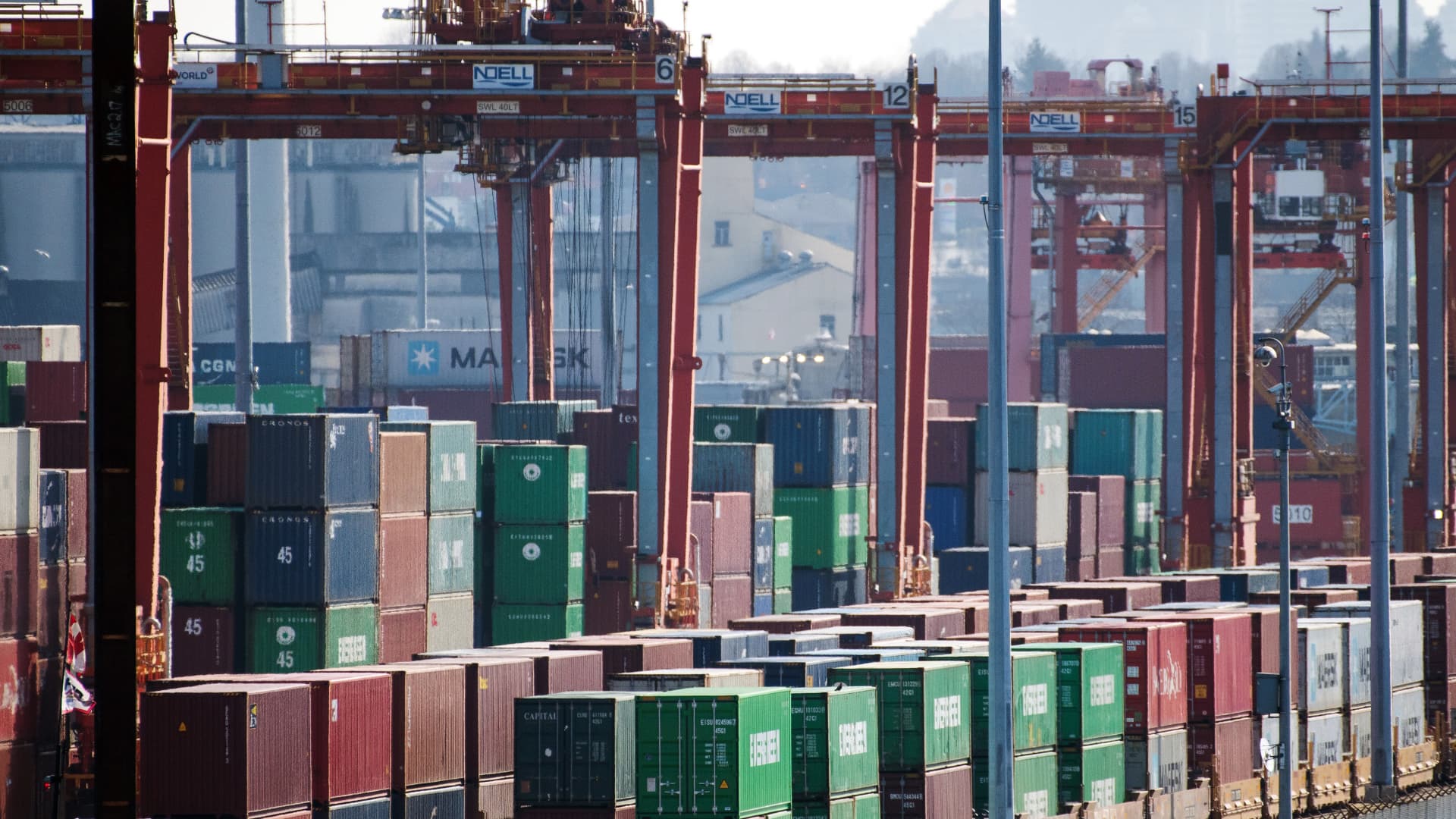Shipping containers are loaded onto rail cars at the Global Container Terminals Vanterm container terminal on Vancouver Harbour in Vancouver, British Columbia, Canada.
Bloomberg | Bloomberg | Getty Images
Weekly rail trade data from the Association of American Railroads reveals the significant negative impact of the Canadian West Coast ports strike on freight rail cargo entering the U.S.
Last week, year-over-year intermodal Canadian rail declined by 46.2% due to the strike. Industries significantly affected include lumber and wood products, oil and petroleum products, non-metallic minerals, and chemicals.
In a statement, the AAR acknowledged that the July 4 holiday may have influenced the decline, but emphasized that “this traffic decline is a clear indication of the Western Canadian ports strike’s impact on rail customers and the broader North American economy. The longer the situation continues, the more severe the impact on the North American supply chain.”
According to U.S. Census data, approximately $572 million worth of container trade arrives in the U.S. from Canada every day. From January 2022 to May 2023, monthly U.S. goods imported from Canada ranged from $31 billion to nearly $41 billion, with top imports including mineral fuels, vehicles, and computer-related machinery.
The strike by the International Longshoremen and Warehouse Union of Canada began on July 1. Negotiations between the ILWU Canada and the British Columbia Maritime Employers Association have been tense, with both parties seeking assistance from federal mediators to reach a resolution.
The U.S. and Canada share a historically strong trade relationship, with each country being the other’s top trading partner. Approximately 20% of U.S. trade arrives in the Canadian ports of Vancouver and Prince Rupert, where strikes occurred after failed negotiations. The Canadian Chamber of Commerce estimates that $605 million worth of trade passes through these ports daily.
According to the Railway Association of Canada, it could take three to five days for networks and supply chains to recover for each day that the strike lasts. This means that if the strike were to end on its twelfth day, rail container delays could range from 36 to 60 days. This does not account for additional delays for vessels waiting to be processed.

Vessel diversions and the reassignment of containers on other vessels to the United States will increase the volume in the U.S. rail system, according to Paul Brashier, Vice President of Drayage and Intermodal at ITS Logistics. This will also lead to additional time and charges such as rail fees, customs fees, and port handling fees.
The decline in trade reflects the cargo diversion from Vancouver and Prince Rupert to the United States. The disruption in trade volume has raised concerns about supply chain issues in the U.S.
ITS has designated both the U.S. West Coast and East Coast rail ramps as red in its freight index, indicating future congestion caused by the strike.
“As container wait times in Western Canada increase due to the duration of the strike, the freight will overwhelm rail lines and ramps when it eventually transfers from the ocean terminals to the interior point rail ramps,” said Brashier.
According to VesselsValue data, there are currently 14 container vessels anchored offshore at Vancouver and Prince Rupert, representing $7.6 billion of trade.
“A significant amount of product flows through Vancouver from Asia and is transported by rail to destinations like Chicago,” said Eric Byer, CEO of the National Association of Chemical Distributors. Byer stated that some members are experiencing delays of three to four weeks due to the strike, but noted that there is excess capacity in the market. However, he highlighted the importance of ending the strike soon to prevent further strain on the supply chain.
The National Association of Chemical Distributors reported that products such as paints, coatings, and acids from Asia are particularly affected.
U.S. ports serving diverted ships, despite union claims
ILWU president Willie Adams, who returned to Canada for a union rally, stated that union workers will not serve any vessels that have been redirected. However, activity at U.S. ports suggests otherwise, with vessels like OOCL San Francisco, MSC Sara Elena, Hyundai Faith, and CMA CGM Medea being serviced. It would be challenging for the ILWU to identify containers with changed destinations due to security restrictions on container information.
The ILWU West Coast chapter in the U.S. did not respond to a request for comment.
A statement on Twitter by the Canadian Labor Minister stated that the differences between the union and port ownership are not significant enough to justify a work stoppage. The minister requested senior federal mediators to draft a deal within 24 hours. Once the labor minister receives the deal, both parties will have 24 hours to decide whether they agree or not.
The government’s action would not end the strike, and the union criticized the Labor Minister’s stance, stating that it would be hypocritical for the government to force longshore workers back to work while not imposing contract terms on shipping companies.
Wages have been a key point of contention in the negotiations, with the ILWU highlighting that wages have not kept pace with inflation. The real purchasing power of longshore wages has declined by 2.5% since 2017, and longshore wages have grown at a slower rate than wages in the overall Canadian economy.
Recently, the Bank of Canada raised its benchmark interest rate to a 22-year high of 5% and indicated the potential need for further rate hikes to combat inflation. This strike, along with other disruptions in supply chains, presents challenges in terms of inflation and inventory during the peak shipping season.
The American Apparel and Footwear Association has called for the recall of Parliament to address the hurdles faced in accessing goods stuck on boats or diverted to other ports.
Denial of responsibility! VigourTimes is an automatic aggregator of Global media. In each content, the hyperlink to the primary source is specified. All trademarks belong to their rightful owners, and all materials to their authors. For any complaint, please reach us at – [email protected]. We will take necessary action within 24 hours.


